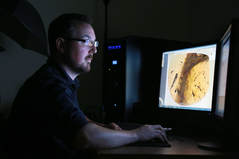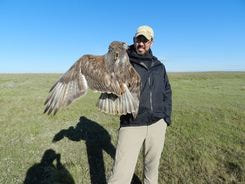Co-Supervisors
I currently co-supervise graduate students with the scientists listed below. Co-supervision enables partnerships and synergy between the university and other institutions.
Dr. ryan mckellar - royal saskatchewan museum
|
Dr. McKellar's research involves three different approaches to the study of amber—examining amber inclusions, the chemical signatures of resins and ambers, and the stable isotopic composition of amber. Together, these three aspects allow observation of palaeoforests and their inhabitants through time. Amber deposits in western Canada offer a particularly important glimpse of insect evolution in the Late Cretaceous, when many of the groups that characterize modern ecosystems were rising to a position of prominence.
ryan.mckellar(at)gov.ca https://royalsaskmuseum.ca/rsm/research/palaeontology/ryan-mckellar Image: Dr. McKellar examines a magnified view of amber containing inclusions. |
dr. ryan fisher - royal saskatchewan museum
|
Dr. Ryan Fisher is the Curator of Vertebrate Zoology at the Royal Saskatchewan Museum. Ryan is interested in many wildlife and landscape management issues in the province of Saskatchewan, with a particular focus on grassland bird species at risk.
ryan.fisher(at)gov.sk.ca Website: https://www.uregina.ca/science/biology/people/associate-adjunct/fisher-ryan.html Image: Ryan holds a dark morph Ferruginous Hawk that is now sporting a satellite transmitter to track its movements during migration. |
Current Students and Post-docs
Brandon Vriends - Ph.d. student

Brandon is studying aquatic communities in southern Saskatchewan, and how different groups of animals respond to water use by humans. His focus is on fish and turtles, with elements of limnology, ecology, and habitat selection. Brandon did his previous training at the University of Prince Edward Island and has broad expertise in aquatic animal biology.
Zachory Eltom - M.sc. Student
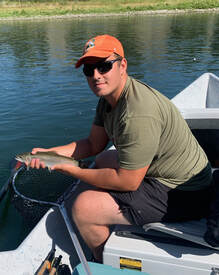
Zachory (Zach) is studying aquatic communities in southern Saskatchewan reservoirs, with a focus on upcoming changes to water usage in the energy industry. He is interested in food web structure and how sport fish are making a living in highly human-modified ecosystems. Some sites for Zach's fieldwork include Boundary Dam, Rafferty, and Cookson Reservoirs.
Mariana Pinho - m.sc. student

Mariana is studying aquatic invertebrates in Saskatchewan reservoirs, and how they respond to the intensity of human influence in different areas. She is focusing on the northern crayfish, a large crustacean, as well as other aquatic species. Her research will help us understand how different taxonomic groups are affected by human activities in these important surface waters. Invertebrates are a key component of aquatic ecosystems and major food source for fish, so the outcome of her work is of great interest for fisheries conservation and management.
katlin mccallum - m.sc. student
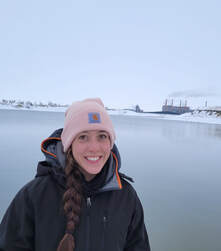
Katlin (Kat) is studying long-term changes to Saskatchewan waterbodies that will occur as coal-generated electricity is phased out as part of climate change mitigation plans. Some reservoirs have been receiving warm effluent from coal-fired plants for decades, creating artificially warm systems for fish and other biota. Perhaps the most famous example in Saskatchewan is Boundary Reservoir, which is home to the only population of largemouth bass in the province. What will happen to this fishery as the warm water is turned off? Stay tuned!
Jessie Bainbridge - m.sc. student
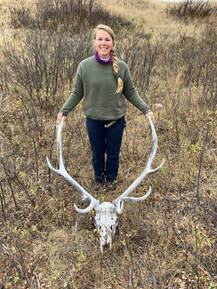
Jessie is studying the conservation biology of Ord's kangaroo rat. This endangered species is a sand-dune specialist that lives in select areas of Alberta and Saskatchewan. Jessie is studying habitat features that promote kangaroo rat productivity, as well as genetic population structure and barriers to gene flow. She is co-supervised by Dr. Ryan Fisher, Curator of Vertebrate Zoology, at the Royal Saskatchewan Museum https://royalsaskmuseum.ca/research/biology/ryan-fisher
Yuliya Shtymburska - m.sc. student
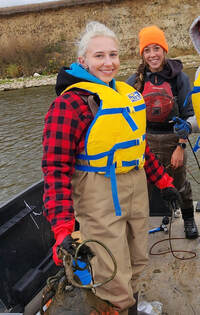
Yuliya is studying trophic ecology and mercury contamination levels in freshwater fish. Her work links ecological processes and mercury cycling to provide a better understanding of contamination risks. Species of interest include yellow perch, a popular species targeted by anglers, and crayfish, a macro-invertebrate that is a good indicator species. Yuliya is co-supervised by Dr. Britt Hall in the Department of Biology at the University of Regina https://www.uregina.ca/science/biology/directory/academic-staff-and-adjuncts/britt-hall.html
April dejong - M.sc. student
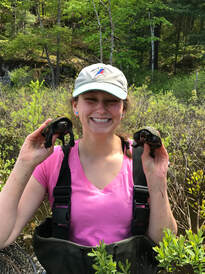
April is studying how changes to the energy industry in prairie Canada affect the lives of bats and their insect prey. Her specific research is on the development of utility-scale solar power production in southern Saskatchewan. April uses a combination of field surveys and automatic recording units for her work; she is co-supervised by Dr. Mark Brigham in the Department of Biology.
https://birdandbatlab.weebly.com/
https://birdandbatlab.weebly.com/
jay vavadia - m.sc. student
|
Jay is studying how changes to the energy industry in prairie Canada affect the lives of birds and the plants they rely on. His specific research is on the development of utility-scale solar power production in southern Saskatchewan. Jay uses a combination of field surveys, remote cameras, and automatic recording units for his work; he is co-supervised by Dr. Ryan Fisher at the Royal Saskatchewan Museum.
https://royalsaskmuseum.ca/research/biology/ryan-fisher |
